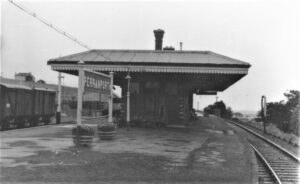Cornwall's railway past
Cornwall is a land that continues to give for the future from its past is something I like to remind people. The centuries old mining industry has created the “Cornish Mining World Heritage Site” for which Cornwall is world famous. Outside the ten mining districts that make up the whole, is other infrastructure that we now benefit from, built in the 19th century. Besides the existing railway lines that survive today there were numerous other branch lines and mineral tramways constructed. These criss-crossed Cornwall moving vast quantities of minerals from mines and quarries to ports around the coast. Towns such as Newquay, originally a small fishing village became one of those places that expanded through a mineral tramway used for exporting minerals. Here the minerals were moved from the Fowey Consuls mines to Newquay across the middle of Cornwall and along the way, as with many railway lines, new smaller communities became established and grew into villages and small towns. The community of St Columb Road, originally called Halloon until 1878, grew around the railway station opened in 1876. Cornwall’s tramways and railways were run by numerous different private companies until finally amalgamated under the Great Western Railway.
Many railway lines built in the 19th century remain however, a good number were closed as considered no longer viable. The mineral and goods carrying needs are long gone and passenger numbers do not support these smaller branch lines between communities. But all is not lost as we are now increasingly seeing some of these being considered for 21st century transport projects. Some of these established during the late 20th century have proved very successful. One of the most popular and well known is the Camel Trail, used by thousands of people each year for cycling and walking. This takes in beautiful scenery as well as historical features. Cornwall Council is currently working on four new trails that can be used for walking, cycling and horse riding. One of these in particular utilises much of the original railway line between Newquay and Perranporth.
So, what about the history of the lost railway line between Perranporth and Newquay? From 1877 the Cornwall Railway [CR] was operated by the Great Western Railway [GWR] before they took over complete ownership in 1889. The GWR had also been operating the Cornwall Mineral Railway [CMR] which included the Par to Newquay line, which had been run by the CMR since 1874 and formerly by the Newquay and Cornwall Junction Railway. This was taken over completely in 1896.
Chacewater had a main line railway station from 1852 with the GWR completing a branch line from Chacewater to Perranporth in 1903, this was extended to Newquay and completed in 1905. This had also created major improvements for the Newquay railway station which was completely overhauled. The work was undertaken with an eye for the future, which saw the first through train from Paddington to Newquay in May 1906. Passenger travel was also made easier from both Penzance and Truro to Newquay via Chacewater.
On the opening day of the Perranporth to Newquay line on 2nd January 1905, 300 children and 8 teachers were treated to a round trip Newquay to Perranporth. With Newquay’s growing tourist population and trade the Newquay-Perranporth line proved very busy during the summer months and also on through to St Agnes. Both St Agnes and Perranporth benefited from this line with upgrade to St Agnes railway station in 1937 and an additional halt at Perranporth beach in 1931. The line ran through Goonhavern and via Mitchell and Newlyn East all of which had halts as well as others.
Of course, we all now know now that this was not to last and increased use of motor vehicles during the 1950 and into the 1960’s saw use of these smaller branch lines decrease. Gradually smaller railway stations closed throughout Cornwall and the lines became disused. The stations and halts along the line that ran from Chacewater through to Newquay were amongst the last with them all closing on 4th February 1963. Newquay would remain but became very diminished from the heyday of railway travel. In time the longest platform in Cornwall at Newquay would be reduced to a stump, along with the service now just along the Par – Newquay line.
With the new emphasis on healthy living that includes cycling and walking a new day dawns for what remains of the railway route from Newquay to Perranporth. If what has been seen happen economically on the Camel Trail takes place with this new project both Newquay and Perranporth will reap a healthy economic reward. A fine example of embracing Cornwall’s historic heritage for modern activities and encouraging people to learn more about it from their experiences.
In this and future railway related articles I must acknowledge the work of renowned railway author John Vaughan, from whom Association for Cornwall Heritage acquired his Newquay collection of images used in his various books. Also, friend of many throughout Cornwall the late Stan May, from whose collection, that ACH preserved following his death, information and images will be shared.





![Perranporth Railway Station c1905 [GWR Chacewater-Newquay] Perranporth Railway Station c1905 [GWR Chacewater-Newquay]](https://www.cornwallheritage.com/wp-content/uploads/2020/08/Perranporth-Railway-Station-c1905-GWR-Chacewater-Newquay-300x187.jpg)




